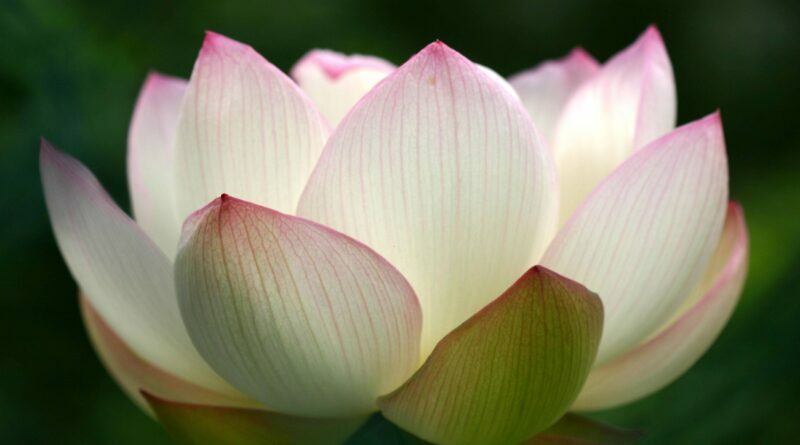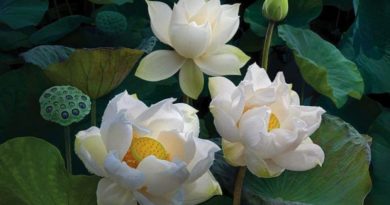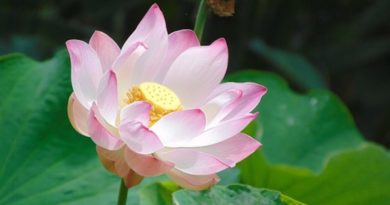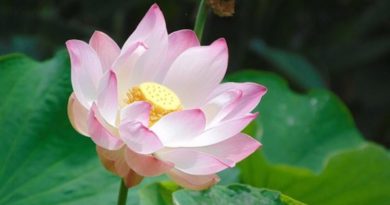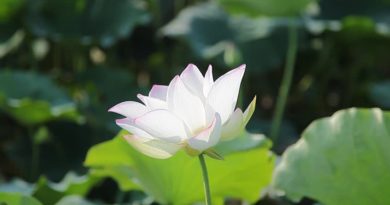VIPASSANA MEDITATION – CHAPTER 2: PRELIMINARY INSTRUCTIONS FOR MEDITATORS
MAIN CONTENT
VIPASSANA MEDITATION – CHAPTER 2: PRELIMINARY INSTRUCTIONS FOR MEDITATORS
In the teachings of the Buddha, there are three kinds of training:
- Training in moral conduct (sila)
- Training in concentration (samadhi), and
- Training in wisdom, insight or enlightenment (panna)
When we practise moral conduct, it means having restraint in speech and actions, i.e. observing at least five precepts or eight precepts as laymen, and for the Sangha (community of monks), the 227 precepts rules of training known as the Patimokkha. When we abstain from unwholesome actions and speech, we observe these precepts completely. When we observe the five precepts, we have to abstain from killing, stealing, sexual misconduct, telling lies and using any kind of intoxicant.
The first precept, abstention from killing, means refraining from unwholesome actions. The second precepts, abstention from stealing and illegal possession of things not given by the owner, means refraining from unwholesome actions. It is the same with the third and fifth precepts, i.e. abstention from sexual misconduct and intoxicants. The fourth precept, abstention from telling lies is refraining from false and unwholesome speech. Therefore, if we refrain from unwholesome speech and actions, our sila is fully observed.
During a meditation retreat, you have to observe the eight precepts so that you can have more time to devote to meditation.
The sixth precept means abstention from taking food after noon (until dawn the next morning). Although you must refrain from taking any kind of food during these hours, you can take honey and certain kinds of fruit juice such as orange and lemon juices.
To observe the second precept, you must refrain from dancing, singing, playing and listening to music and adorning yourself with anything which will be beautify yourself such as using flowers, perfumes and so on.
The eighth precept is abstention from high and luxurious beds. The third of the eight precepts refers to abstention from any kind of sexual contact, and not just from sexual misconduct. By refraining from these activities, your speech and actions are pure. These are the eight precepts you will have to observe during your retreat.
Observing eight precepts means purification of moral conduct – Sila visuddhi. Sila visuddhi is a prerequisite for a meditator to make progress in meditative practice. When moral conduct is purified, one never feels guilty. When one does not feel guilty, ones mind becomes steady, thereby, one can easily attain deep concentration of mind (samadhi) which, in turn, gives rise to insight wisdom (panna).
Part 1 – What Is Vipassana?
Vipassana is a Dhamma term which is a combination of two words. Vi is one word, passana is the other. Here, vi refers to the three characteristics of mentality and physicality, i.e. impermanence. (anicca), unsatisfactoriness or suffering (dukkha) and no soul, no self or non ego (anatta). Passana means right understanding or realization through deep concentration, or right understanding of the three characteristics of mentality (nama) and physicality (rupa). When we practise Vipassana meditation or mindfulness meditation, the purpose is to realise, anicca, dukkha and anatta – the three characteristics of phenomena.
By realizing these three characteristics of mentality and physicality, we can exterminate every defilement such as lust, greed, desire, craving, hatred, ill will, jealousy, conceit, sloth and torpor, sorrow and worry, restlessness and remorse. Having destroyed all these defilements, we then attain deliverance or the cessation of suffering. As long as we have any of these defilements, we are sure to experience many kinds of dukkha (suffering). Defilements (kilesas) are the cause of suffering, therefore, when defilements have been destroyed, all kinds of suffering cease to exist.
Part 2 – Mindfulness Of The Four Elements
During the practice, we must observe each and every mental and physical process which is arising at the moment. In the beginning of the practice, we must contemplate the abdominal movements as instructed by the Most Venerable Mahasi Sayadaw. Contemplation of the abdominal movements is in accordance with the Maha Satipatthana Sutta, the Discourse on the Four Foundations of Mindfulness. In that discourse, there is a chapter concerning mindfulness of the four elements. There the Buddha teaches us to be mindful of the four elements when they arise pathavi dhatu – earth element, apo dhatu – water element, tejo dhatu – fire element and vayo dhatu – wind element). Not only these four elements but all mental and physical phenomena must be observed.
We must understand that the earth element is not actually the earth. Instead it refers to the true nature of the earth element. Earth element is the name given to its individual characteristics, such as hardness and softness. The scriptures say. “Hardness and softness are the individual or specific characteristics of the earth element” – so when you thoroughly realise hardness or softness in any part of your body, it means that you are realizing the true nature or individual characteristic of the earth element(pavthavi dhatu).
Water element is not actually water but the term given to the individual characteristics of the element. Fluidity and cohesion are characteristics of the water element (apo dhatu). When you realise the nature of fluidity or cohesion in any part of your body, it means you are realizing the water element. Similarly, the fire element is not really fire, but the specific characteristic of the element. Heat and cold are the specific characteristics of the fire element (tejo dhatu). Wind element (vayo dhatu) likewise is not wind but the term given to the specific characteristics of the wind element, that is, movement, motion, vibration or support in any part of your body. When you feel, realise and rightly understand this movement, motion, vibration or supporting nature in any part of your body, it means that you are realizing the wind element. This is mindfulness of the four elements.
The Omniscient Buddha said, “Any mental or physical process must be observed as it is.” When we sit in any comfortable position and focus our mind on the mental and physical processes, we may not know which object must be observed first. So, to overcome this difficulty, the Most Venerable Mahasi Sayadaw instructed his meditators to begin with the abdominal movements. When we breathe in, the abdomen rises, when we breathe out, the abdomen falls. We should focus our mind on the abdominal movement. When the abdomen rises, we should note it as rising, and when it falls, as falling. In this way: rising, falling, rising, falling. Thus we can feel the inward and outward movement of the abdomen. This specific characteristic of vayo dhatu must be thoroughly realized by meditators so that they can destroy the false view of a person, a being or a soul. They must observe the inward movement and outward movement of the abdomen or the rising and falling movement of the abdomen, making a mental note of rising, falling, rising, falling.
During the contemplation of your abdominal movement, when you hear a sound which is loud enough to be noted, then you should note, hearing, hearing, hearing. At the beginning of the practice, you may not overcome it, so you should note, hearing, hearing as much as possible. When you think it is enough for you to stop, then you should return to the primary object, the abdominal movement. Sometimes the sound may last for a second or two. Then, when the sound has disappeared, your mind will naturally go back to the primary object, rising and falling which you should note as usual.
Part 3 – Mindfulness Of Mental And Emotional States
When you feel happy or unhappy, or when you feel sorry and sad, these emotional states must be observed as they really are – mentally noting, happy, happy or unhappy, unhappy or sad, sad, and so on. After the emotional state has disappeared, the noting mind naturally returns to the abdominal movement, which should be observed as usual. When your mind goes out and thinks about your work, your family or your relatives, you must leave the abdominal movement a lone and observe the wandering thoughts, making a mental note thinking, thinking. You should be careful at this point. When you observe any mental state or emotional state, your noting mind must be energetic, attentive, precise and somewhat quick so that it becomes continuous, uninterrupted and constant. When the noting mind becomes powerful, the thought or idea, or the thinking mind stops by itself. Then the noting mind no longer has the object to note. It naturally returns to the abdominal movement which should be noted as usual.
Part 4 – Walking Meditation
The Buddha said that mindfulness must be applied to the four postures of the body, i.e. walking, standing, sitting and lying down.
- While you are walking, you must be mindful of it as it is-
- While you are standing, you must be mindful of it as it is-
- While you are sitting, you must be mindful of it as it is-
- _ hile you are lying down, you must be mindful of it as it is-
So, in every posture, there must be mindfulness.
We instruct meditators to practise walking and sitting meditation alternately so that they can concentrate more easily and hence attain insight into the walking and sitting processes. Every session of sitting must be preceded by walking because in walking meditation, the movement of the foot is more distinct than the abdominal movement when sitting. When your meditation practice matures, you may then need sitting meditation for a longer period than walking. When you have reached the sixth stage of insight knowledge, you may practise sitting meditation longer than walking you may sit for two or three hours and walk one hour. At that stage, your concentration is good, deep and strong enough to realise the dissolution of nama and rupa (mental and physical phenomena). But in the beginning of the practice, you need walking meditation longer than sitting because you are not yet able to sit for long but can walk longer. You can attain some degree of concentration more easily in walking than in sitting.
So first of all, you should practise walking meditation by being aware of stepping. When you make a left step, note it as left. When you make a right step, note it as right. In this way, note left, right, left, right, or just stepping, stepping. Labelling or naming is not so important as the mind that observes the movement of the foot. You should lay stress on awareness, sharp awareness of the movement of the foot.
When you practise walking meditation, you must not close your eyes. Instead, your eyes must be half closed (that means, relax and keep your eyes normal) and you should look at a place on the floor about four or five feet in front of your foot.
You must not bend your head too low. If you bend your head too low, you will soon feel tension in your neck or shoulders. Also, you may have a headache or dizziness. You must not look at your foot. If you look at your foot, you cannot concentrate well on the movement. Nor must you look around here and there. Once you look around, the mind goes with the eyes; then your concentration breaks. You may have a tendency or desire to look around when you feel that someone is coming towards you or passing in front of you. That tendency or desire to look around must be very attentively observed and noted as tendency or wanting to look until it has disappeared. When the tendency or desire has disappeared, you won’t look around. Then you can maintain your concentration. So, please be careful not to look around so that you can maintain your concentration and make progress in your attainment of concentration by walking meditation. Your hands should be locked together in front or behind. If you feel you should change the position of your hands, you may do so, but mindfully.
When you have an intention to change position, you should note intending, intending. Even then, you should change the position very slowly and every action and movement involved in the act of changing must be observed. You must not be unmindful of any movement or action. When you have changed the position of your hands, then you should continue to note the movements of the foot as before.
In sitting meditation too, those who have some experience in meditational practice should sit at least 45 minutes without changing position. Beginners should sit at least 20-30 minutes without changing position. If a beginner is unable to bear the severe pain which arises, he may feel like changing his posture. Before doing so, he must note the intention to change posture, as intending, intending. Then he should change his posture very, very slowly being aware of all the movements and actions involved in the changing of postures. When he has changed his posture, he should then return to the abdominal movement, the primary object, and note as usual.
Part 5 – Silent Awareness
In a meditation retreat, you must not do any action or movement quickly. You must slow down all actions and movements as much as possible so that you can apply mindfulness to every minute movement or action of the body. At home, you need not slow down all these actions and movements but rather, they should be normal, and mindfully observed. All actions and movements must be mindfully noted as they really are. That is general mindfulness. In a retreat, you must slow down all actions and movements because you have nothing else to do except to be mindful of all your mental and physical activities. You must not talk. except for the few words which are necessary in your daily routine, but these few words should also be spoken slowly and softly so that your words do not disturb the concentration of other meditators. You should do everything with very little noise or without any noise. You must not make a sound by walking sluggishly and heavily. If you are mindful of the movements of your foot, you wont make any sound when walking.
You must be mindful of whatever arises in your body and mind. You must be aware of any activity of your mind and body as it really is. As you are eating, you must be mindful of all the actions and movements in eating. When you are taking a bath, dressing or drinking water, you must slow down all your actions and observe the movements. When you sit down, you should do it very slowly, being aware of the whole movement of sitting. When you stand up, that must also be done very slowly by being aware of the movement because we want to realise every mental or physical process in its true nature. All mental and physical processes are ever changing – appearing and disappearing, arising and vanishing. We want to realise this true nature of mental and physical processes. Therefore, we should slow down all actions and movements.
Mindfulness and concentration will pave the way for insight to unfold. When mindfulness becomes continuous, naturally the concentration becomes deeper. When the concentration becomes deeper, insight will unfold by itself. Therefore, we should strive to have constant and continuous mindfulness.

